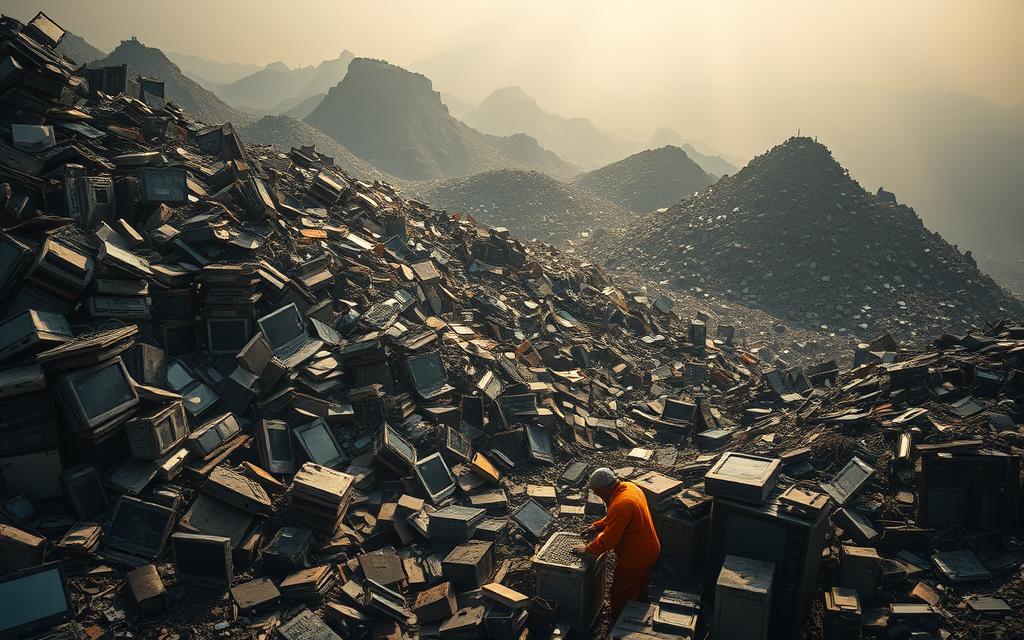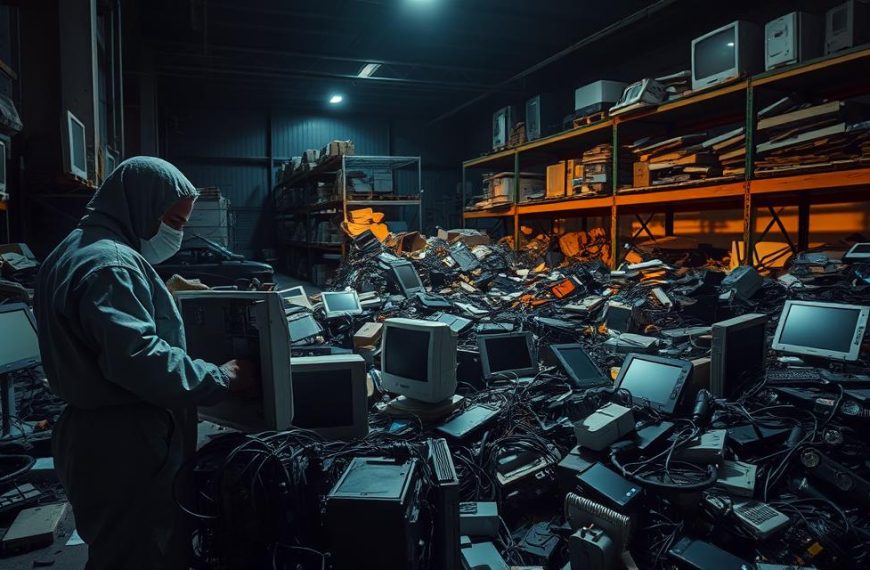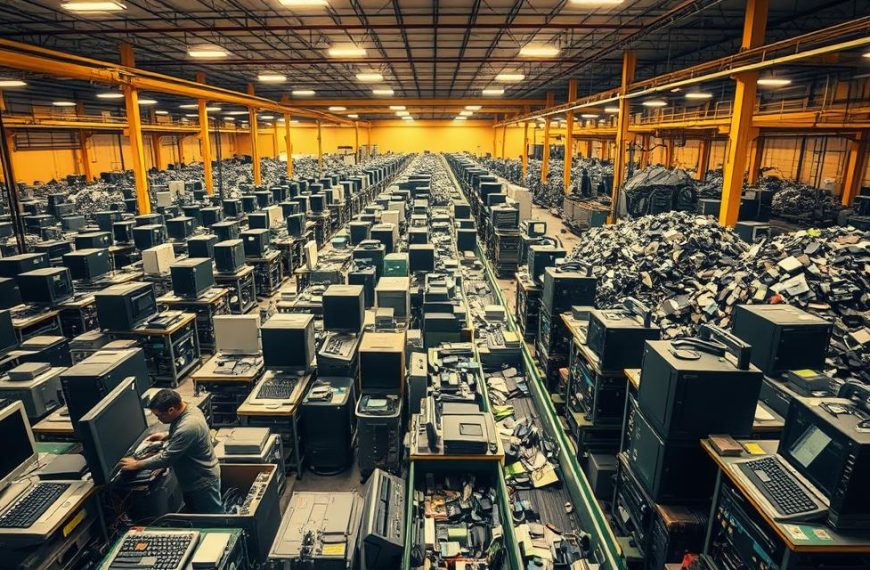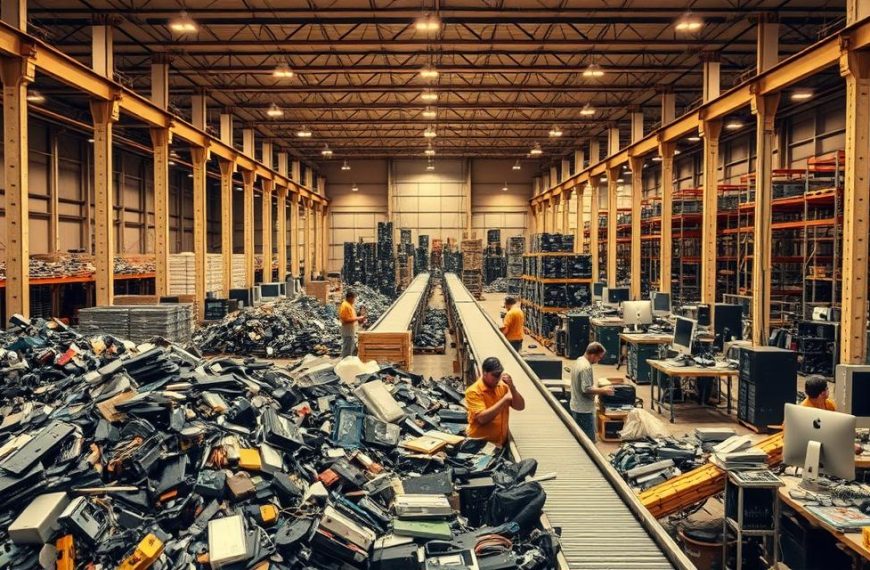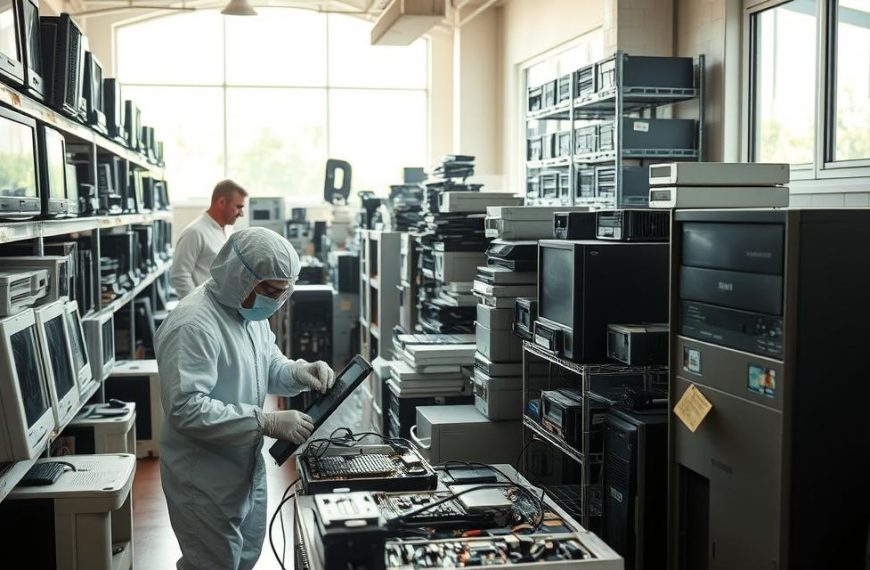Our world today throws away a lot of electronic waste every year. Old computers and gadgets are among the fastest-growing waste types globally.
This is a big problem for our environment. Many devices have harmful materials like lead, mercury, and cadmium. These can pollute soil and water if they end up in landfills.
Proper e-waste disposal tackles several issues at once. It keeps our environment clean and helps reuse valuable resources.
Responsible computer disposal also keeps your data safe. Experts ensure all data is wiped out during recycling.
Knowing how to recycle electronics is key for everyone. This guide will help you manage your electronic waste the right way.
Understanding IT asset disposal is vital for our planet and resources. It’s a big step towards using technology in a sustainable way.
The Critical Importance of Responsible PC Recycling
Old computers are more than just outdated tech. They hold valuable resources and dangerous substances that need careful handling. Recycling them properly helps us get these materials back while keeping our environment safe.
Environmental Hazards of Electronic Waste
Computers have parts that can harm our environment if not disposed of right. Heavy metals like lead, mercury, and cadmium can leak into soil and water. This can lead to long-term pollution in our food chain.
Plastic casings and circuit boards also contain harmful chemicals. These can stay in the environment for a long time, affecting our water and ecosystems. It’s vital to manage these risks through recycling.
Electronic waste is also a waste of valuable resources. Computers have metals like gold, silver, and platinum. Mining these can harm the environment. Recycling helps reduce the need for new mining, saving energy and resources.
| Hazardous Component | Potential Environmental Impact | Health Risks |
|---|---|---|
| Lead | Soil and water contamination | Neurological damage |
| Mercury | Water system pollution | Kidney and brain damage |
| Cadmium | Persistent soil contamination | Respiratory and bone diseases |
| Flame Retardants | Ecosystem disruption | Endocrine system interference |
US Regulatory Framework for E-Waste
In the US, states have their own rules for dealing with electronic waste. Twenty-five states and Washington D.C. have laws that make manufacturers pay for recycling. This is different from a single federal law.
These state laws are inspired by the European Union’s WEEE Directive. Even though it’s not a US law, it has influenced many state rules. It makes manufacturers responsible for recycling, not taxpayers.
California has its own recycling act for electronic devices. It charges a fee when you buy them. Other states like Washington and New York make manufacturers take back old devices.
The Environmental Protection Agency helps with recycling through its Sustainable Materials Management programme. It encourages manufacturers to make products easier to recycle. This mix of laws and voluntary actions tackles e-waste problems effectively.
Essential Preparation Steps Before PC Recycling
Getting your old computer ready for recycling is key. It turns a possible security risk into something valuable. These steps keep your data safe and make sure parts can be recycled well.
Comprehensive Data Backup Procedures
Protect your digital world before recycling starts. A good data backup plan saves your files, photos, and documents from being lost forever.
Here are some backup options:
- External hard drives for local storage
- Cloud-based services for off-site protection
- Network-attached storage for larger collections
- Multiple backup locations for redundancy
It’s important to check if your backup worked. Make sure it did before you start any data destruction steps.
Secure Data Erasure Techniques
Just deleting files or formatting drives isn’t enough. True secure disposal needs more to stop data from being found again.
Special data wipe software writes over your data many times. It meets high standards for cleaning data.
“A single pass overwrite sufficiently protects against typical data recovery attempts when using modern storage media.”
For solid-state drives, special data destruction software uses built-in commands. This makes data on flash drives impossible to recover.
Component Separation and Organisation
Sorting parts makes recycling easier and better. Different materials need different ways of being handled at recycling places.
Here’s how to do it:
- Disconnect all cables and peripherals
- Separate monitors from central processing units
- Remove easily accessible components like RAM and hard drives
- Group similar materials together for efficient processing
This way, recycling centres can sort materials right. It also helps find parts that need special care during IT equipment recycling.
Getting ready right ensures recycling is good for the planet and keeps your data safe. These steps help recycle your computer well and protect your digital life.
Available PC Recycling Programmes and Services
When your computer is no longer useful, there are many ways to dispose of it responsibly. Knowing about these options helps protect your data and the environment.
Manufacturer Take-Back Initiatives
Many computer makers have take-back programmes. These let you return old devices to the company that made them.
Big names like Dell, HP, and Apple offer free recycling. Some even send a shipping label or pick up your old computer.
These programmes often include:
- Free return shipping for old devices
- Data destruction guarantees
- Environmental compliance certifications
- Trade-in options for newer models
Retailer Recycling Partnerships
Electronics stores often work with recycling groups. Places like Best Buy and Staples accept computers from anywhere.
Stores might give you credit or discounts for recycling. This can help you save money on new purchases.
“Retail partnerships make responsible electronics recycling accessible to millions of consumers nationwide.”
Local Authority Collection Services
Local governments in the US offer recycling for electronic waste. You can find collection events or drop-off spots.
To find recycling options near you, check your city’s website. Many have special days for electronics.
Some places offer curbside pickup for small items. Always check what your area accepts before putting items out.
Certified E-Waste Processing Facilities
Certified recyclers follow strict rules to protect the environment and your data. They ensure computers are recycled safely.
Look for e-Stewards or R2 certifications. These show a facility meets high standards for safety and the environment.
Certified facilities offer:
- Secure data destruction documentation
- Environmentally sound material recovery
- Transparent processing chain accountability
- Compliance with all relevant regulations
Choosing certified recyclers means your old computer is handled right. It won’t end up in landfills or be sent to other countries.
Data Security Considerations in PC Disposal
Data security risks don’t go away when devices are no longer needed. They need careful handling through proper disposal. Whether it’s business or personal devices, making sure all data is erased is key. This is a big part of good IT asset management.
Physical Media Destruction Methods
Physical destruction is the best way to make sure data can’t be recovered. It makes storage media unusable. This includes shredding, disintegration, and crushing of hard drives and other devices.
Degaussing is another method that uses strong magnetic fields to erase data. It’s very effective for magnetic media. For solid-state drives, shredding or pulverisation is the best option.
Software-Based Sanitisation Solutions
Software solutions are an alternative to physical destruction. They use secure data erasure algorithms to overwrite data. This way, devices can be reused while keeping data safe.
There are many software tools available, each with different levels of certification. They can handle multiple devices at once. For those who want to reuse their equipment, software sanitisation is a green and secure option.
Professional Data Destruction Services
Using professional data destruction services gives the highest level of assurance. They use both physical and software methods and keep detailed records. They provide certificates of destruction, proving they followed data protection laws.
These services take care of everything, from picking up devices to destroying them. They ensure no security gaps. Many offer on-site destruction, where you can see the process. This is great for organisations with sensitive data or needing audit trails.
| Method | Best For | Security Level | Environmental Impact | Cost Consideration |
|---|---|---|---|---|
| Physical Destruction | End-of-life equipment, highly sensitive data | Maximum (irreversible) | Higher (waste generated) | Medium to high |
| Software Sanitisation | Reusable equipment, moderate sensitivity | High (meets standards) | Lower (equipment reused) | Low to medium |
| Professional Services | Businesses, compliance requirements | Maximum with documentation | Varies by method used | Higher (premium service) |
The right choice depends on your data security needs and the condition of your devices. Many use a mix of methods for different devices. Proper physical destruction or verified sanitisation keeps data safe and follows laws.
For more advice on these strategies, check out our detailed guide on data security in computer equipment. It helps organisations find the best balance between security, compliance, and being green.
Conclusion
Proper PC recycling is more than just getting rid of old computers. It shows our dedication to taking care of the environment. By choosing certified recycling services, we make sure harmful materials are dealt with safely. At the same time, we help valuable parts get reused.
Recycling old computers through approved programmes helps build a circular economy. This way, waste becomes resources, cutting down on the need for new materials. It also lessens harm to our planet.
Choosing to recycle responsibly helps make our future greener. Every recycled computer is a step towards less electronic waste. It also saves natural resources for future generations.

